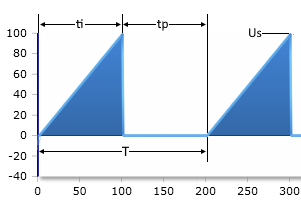RMS value of a sawtooth pulse
Calculator and formulas for calculating the RMS value of a sawtooth pulse voltage
Sawtooth Pulse Calculator
Sawtooth pulse voltage
Enter the values for pulse duration (ti), period duration (T), and the peak voltage Us of the pulse.
Sawtooth pulse & parameters

Parameters
Basic formulas
Example calculations
Practical calculation examples
Example 1: 50% duty cycle
Given: Us = 10V, ti = 50ms, T = 100ms
Example 2: 25% duty cycle
Given: Us = 12V, ti = 25ms, T = 100ms
Example 3: Oscilloscope application
Given: Us = 5V, ti = 2ms, T = 10ms (20% duty cycle)
Duty cycle effects for sawtooth
RMS factor:
Mean value factor:
Formulas for sawtooth pulse
What is a sawtooth pulse?
The RMS value (Root Mean Square) of a sawtooth pulse can be calculated using the general formula for the RMS value of a periodic signal. It is defined as the DC value with the same thermal effect as the considered AC value. For sawtooth pulse voltages, it is calculated as follows.
Definition of RMS value
In a sawtooth pulse, the voltage rises linearly from 0V to the peak value Us over the pulse duration ti, and then remains at 0V for the rest of the period. The entered parameters for T and ti must have the same unit.
RMS value
Depends on the duty cycle and factor 1/√3.
Mean value
Half the value of the rectangular pulse.
Mathematical derivation
Calculation
For a sawtooth pulse over a period T:
Practical applications
Measurement technology
- Oscilloscope time base
- Sweep generators
- Voltage ramps
- ADC test patterns
Signal processing
- Frequency modulation
- VCO control
- Wobbler signals
- Linearization
Control engineering
- Ramp generator
- Setpoint specification
- Integrator test
- Time control
Comparison with other signal forms
RMS factors at 50% duty cycle
Ueff = Us/√2 ≈ 0.707
Ueff = Us/√3 ≈ 0.577
Ueff = Us/√6 ≈ 0.408
Ueff = Us/2 = 0.5
Spectral properties
Harmonics in sawtooth pulses
Sawtooth pulses contain all harmonics with a specific distribution:
Design notes
Practical considerations
- Linearity: Constant rise rate important for precision
- Bandwidth: Fast rising edge requires high bandwidth
- Offset errors: Can affect linearity
- Temperature stability: Important for precise ramp generators
- Reset: Fast reset to 0V required
- Load: Capacitive loads can degrade linearity
|
|